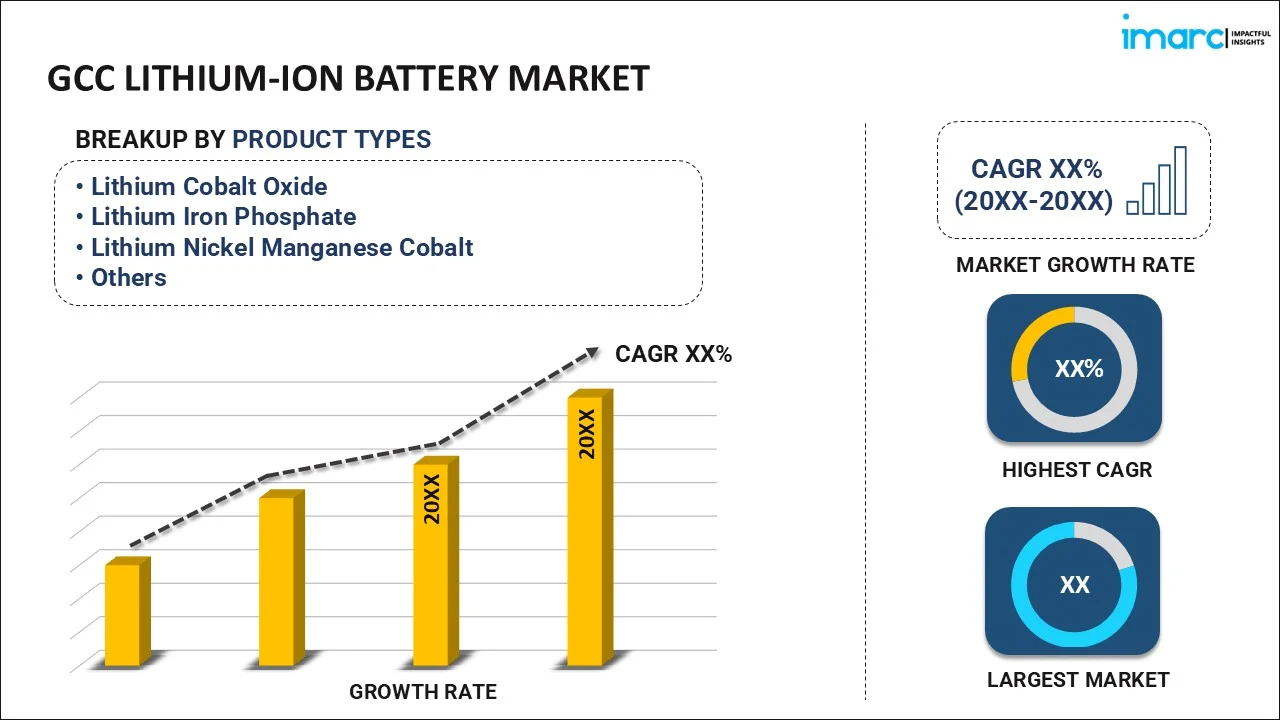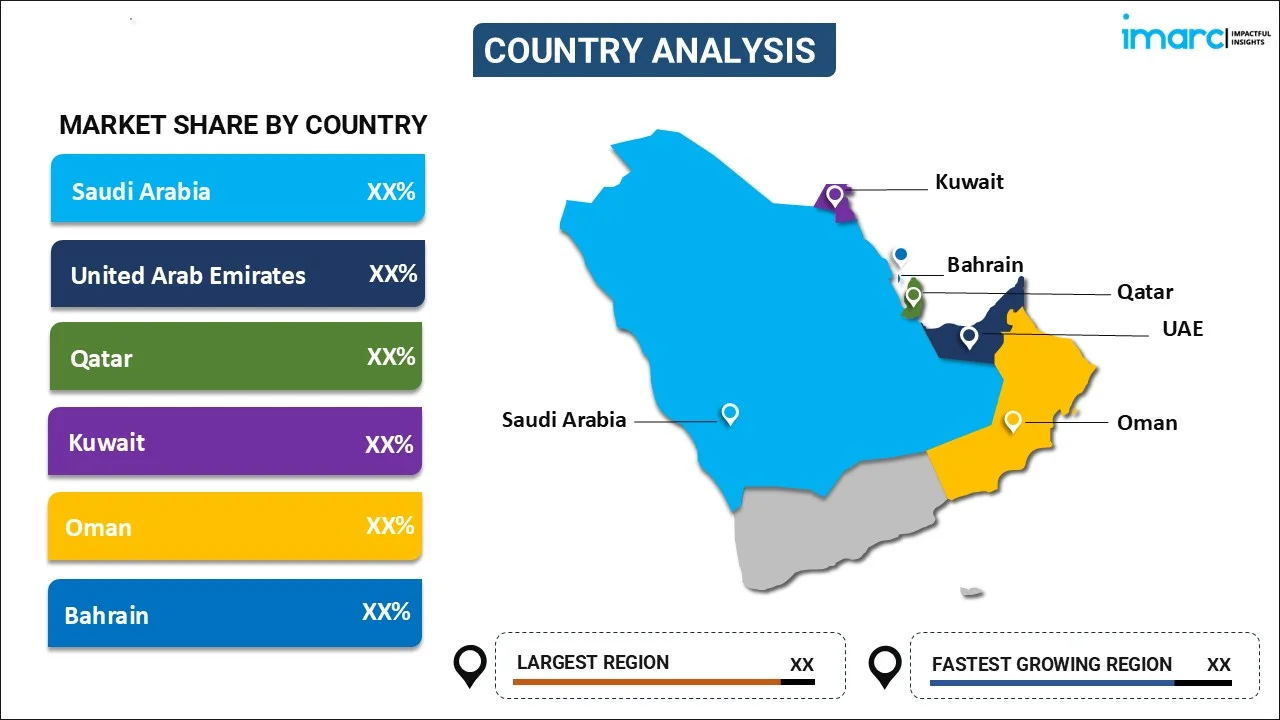
GCC Lithium-Ion Battery Market Report by Product Type (Lithium Cobalt Oxide, Lithium Iron Phosphate, Lithium Nickel Manganese Cobalt, Lithium Manganese Oxide, and Others), Power Capacity (0 To 3000mAH, 3000mAH to 10000mAH, 10000mAH to 60000mAH, More than 60000mAH), Application (Consumer Electronics, Electric Vehicles, Energy Storage, and Others), and Country 2025-2033
Market Overview
The GCC lithium-ion battery market size is projected to exhibit a growth rate (CAGR) of 12.2% during 2025-2033. The increasing emphasis on renewable energy sources, the rising need for efficient energy storage solutions, and the introduction of policies and incentives to encourage the adoption of electric vehicles represent some of the key factors driving the market.
|
Report Attribute
|
Key Statistics
|
|---|---|
|
Base Year
|
2024
|
|
Forecast Years
|
2025-2033
|
|
Historical Years
|
2019-2024
|
| Market Growth Rate 2025-2033 | 12.2% |
A lithium-ion battery refers to a rechargeable energy storage device that has become ubiquitous in modern electronics and portable devices. It is renowned for its high energy density, longevity, and lightweight design. The battery operates through the movement of lithium ions between two electrodes, typically manufactured from a lithium compound and a carbon-based material, within an electrolyte solution. During discharge, lithium ions move from the negative electrode to the positive electrode, releasing energy that powers the device. Recharging reverses this process. The battery has transformed industries, powering everything from smartphones, laptops, and cameras to electric vehicles and renewable energy storage systems. Its capacity to store a significant amount of energy in a compact size has revolutionized the way we interact with technology and energy sources.
GCC Lithium-Ion Battery Market Trends:
The GCC market is driven by the increasing emphasis on renewable energy sources, particularly solar power, within the GCC countries. As these nations seek to diversify their economies and reduce their dependence on oil, they are investing significantly in renewable energy projects. Lithium-ion batteries play a crucial role in these projects by storing excess energy generated during peak sunlight hours, which can then be utilized during periods of low solar activity or high energy demand. This integration of lithium-ion batteries with renewable energy infrastructure not only enhances grid stability but also accelerates the transition towards a more sustainable energy mix. Furthermore, the rapid urbanization and industrialization across the GCC nations have led to a increase in energy consumption. As a result, there is an increasing need for efficient energy storage solutions to manage peak demand and ensure a reliable power supply. Lithium-ion batteries, with their high energy density and quick response times, are well-suited to meet these demands. They enable the grid to balance fluctuations in electricity demand and supply, reducing the risk of blackouts and enhancing overall energy security. Moreover, the GCC region's commitment to electric mobility is yet another catalyst augmenting the lithium-ion battery market. Governments in the region are introducing policies and incentives to encourage the adoption of electric vehicles (EVs) as a means to reduce greenhouse gas emissions and combat air pollution. As EV sales gain momentum, the demand for lithium-ion batteries for use in electric cars and charging infrastructure is expected to soar, creating a significant market opportunity. Collaborations between regional governments, private sector players, and international technology companies are also contributing to the growth of the GCC lithium-ion battery market. These collaborations facilitate the transfer of expertise, technology, and investments, accelerating innovation and the development of advanced battery technologies that are better suited to the region's specific environmental conditions.
GCC Lithium-Ion Battery Industry Segmentation:
IMARC Group provides an analysis of the key trends in each segment of the GCC lithium-ion battery market report, along with forecasts at the regional and country levels for 2025-2033. Our report has categorized the market based on product type, power capacity, and application.
Breakup by Product Type:

- Lithium Cobalt Oxide
- Lithium Iron Phosphate
- Lithium Nickel Manganese Cobalt
- Lithium Manganese Oxide
- Others
The report has provided a detailed breakup and analysis of the market based on the product type. This includes lithium cobalt oxide, lithium iron phosphate, lithium nickel manganese cobalt, lithium manganese oxide, and others.
Breakup by Power Capacity:
- 0 to 3000mAH
- 3000mAH to 10000mAH
- 10000mAH to 60000mAH
- More than 60000mAH
A detailed breakup and analysis of the market based on the power capacity has also been provided in the report. This includes 0 to 3000mAH, 3000mAH to 10000mAH, 10000mAH to 60000mAH, and more than 60000mAH.
Breakup by Application:
- Consumer Electronics
- Electric Vehicles
- Energy Storage
- Others
A detailed breakup and analysis of the market based on the application has also been provided in the report. This includes consumer electronics, electric vehicles, energy storage, and others.
Breakup by Country:

- Saudi Arabia
- UAE
- Qatar
- Bahrain
- Kuwait
- Oman
The report has also provided a comprehensive analysis of all the major country markets, which include Saudi Arabia, UAE, Qatar, Bahrain, Kuwait, and Oman.
Competitive Landscape:
The report has also provided a comprehensive analysis of the competitive landscape in the market. Competitive analysis such as market structure, key player positioning, top winning strategies, competitive dashboard, and company evaluation quadrant has been covered in the report. Also, detailed profiles of all major companies have been provided.
GCC Lithium-Ion Battery Market Report Scope:
| Report Features | Details |
|---|---|
| Base Year of the Analysis | 2024 |
| Historical Period | 2019-2024 |
| Forecast Period | 2025-2033 |
| Units | Million USD |
| Scope of the Report | Exploration of Historical and Forecast Trends, Industry Catalysts and Challenges, Segment-Wise Historical and Predictive Market Assessment:
|
| Product Types Covered | Lithium Cobalt Oxide, Lithium Iron Phosphate, Lithium Nickel Manganese Cobalt, Lithium Manganese Oxide, Others |
| Power Capacities Covered | 0 To 3000mAH, 3000mAH to 10000mAH, 10000mAH to 60000mAH, More than 60000mAH |
| Applications Covered | Consumer Electronics, Electric Vehicles, Energy Storage, Others |
| Countries Covered | Saudi Arabia, UAE, Qatar, Bahrain, Kuwait, Oman |
| Customization Scope | 10% Free Customization |
| Post-Sale Analyst Support | 10-12 Weeks |
| Delivery Format | PDF and Excel through Email (We can also provide the editable version of the report in PPT/Word format on special request) |
Key Questions Answered in This Report:
- How has the GCC lithium-ion battery market performed so far and how will it perform in the coming years?
- What has been the impact of COVID-19 on the GCC lithium-ion battery market?
- What is the breakup of the GCC lithium-ion battery market on the basis of product type?
- What is the breakup of the GCC lithium-ion battery market on the basis of power capacity?
- What is the breakup of the GCC lithium-ion battery market on the basis of application?
- What are the various stages in the value chain of the GCC lithium-ion battery market?
- What are the key driving factors and challenges in the GCC lithium-ion battery market?
- What is the structure of the GCC lithium-ion battery market and who are the key players?
- What is the degree of competition in the GCC lithium-ion battery market?
Key Benefits for Stakeholders:
- IMARC’s report offers a comprehensive quantitative analysis of various market segments, historical and current market trends, market forecasts, and dynamics of the GCC lithium-ion battery market from 2019-2033.
- The research study provides the latest information on the market drivers, challenges, and opportunities in the GCC lithium-ion battery market.
- Porter's five forces analysis assist stakeholders in assessing the impact of new entrants, competitive rivalry, supplier power, buyer power, and the threat of substitution. It helps stakeholders to analyze the level of competition within the GCC lithium-ion battery industry and its attractiveness.
- Competitive landscape allows stakeholders to understand their competitive environment and provides an insight into the current positions of key players in the market.
Need more help?
- Speak to our experienced analysts for insights on the current market scenarios.
- Include additional segments and countries to customize the report as per your requirement.
- Gain an unparalleled competitive advantage in your domain by understanding how to utilize the report and positively impacting your operations and revenue.
- For further assistance, please connect with our analysts.
 Inquire Before Buying
Inquire Before Buying
 Speak to an Analyst
Speak to an Analyst
 Request Brochure
Request Brochure
 Request Customization
Request Customization




.webp)




.webp)












